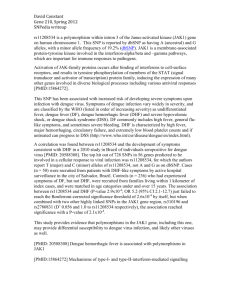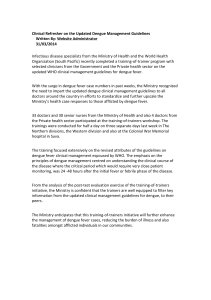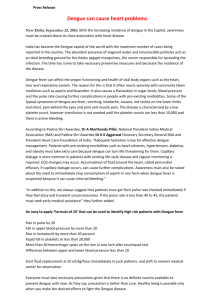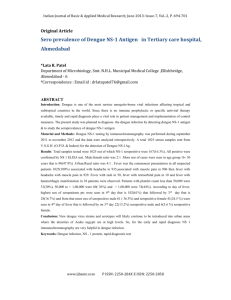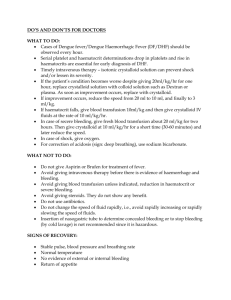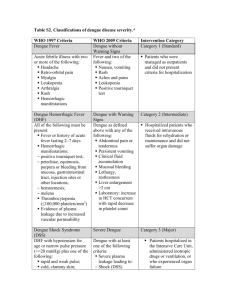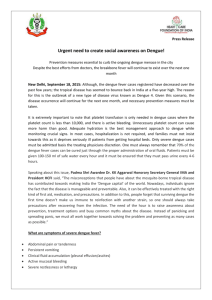clinical profile of dengue haemorrhagic fever from jan 2009
advertisement
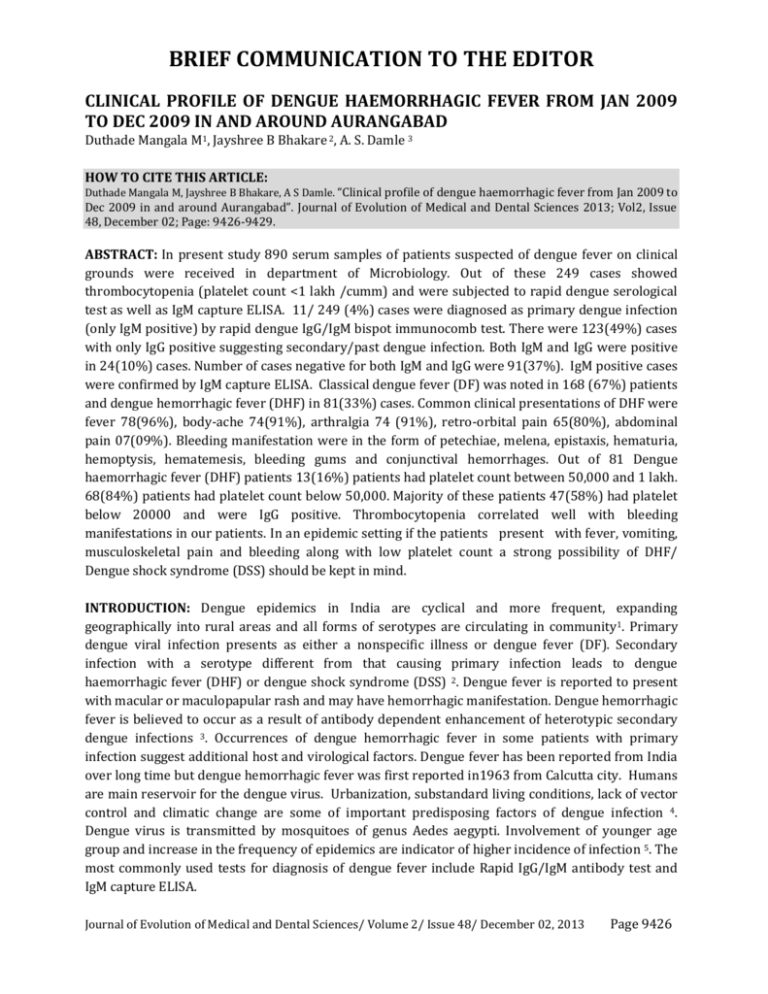
BRIEF COMMUNICATION TO THE EDITOR CLINICAL PROFILE OF DENGUE HAEMORRHAGIC FEVER FROM JAN 2009 TO DEC 2009 IN AND AROUND AURANGABAD Duthade Mangala M1, Jayshree B Bhakare 2, A. S. Damle 3 HOW TO CITE THIS ARTICLE: Duthade Mangala M, Jayshree B Bhakare, A S Damle. “Clinical profile of dengue haemorrhagic fever from Jan 2009 to Dec 2009 in and around Aurangabad”. Journal of Evolution of Medical and Dental Sciences 2013; Vol2, Issue 48, December 02; Page: 9426-9429. ABSTRACT: In present study 890 serum samples of patients suspected of dengue fever on clinical grounds were received in department of Microbiology. Out of these 249 cases showed thrombocytopenia (platelet count <1 lakh /cumm) and were subjected to rapid dengue serological test as well as IgM capture ELISA. 11/ 249 (4%) cases were diagnosed as primary dengue infection (only IgM positive) by rapid dengue IgG/IgM bispot immunocomb test. There were 123(49%) cases with only IgG positive suggesting secondary/past dengue infection. Both IgM and IgG were positive in 24(10%) cases. Number of cases negative for both IgM and IgG were 91(37%). IgM positive cases were confirmed by IgM capture ELISA. Classical dengue fever (DF) was noted in 168 (67%) patients and dengue hemorrhagic fever (DHF) in 81(33%) cases. Common clinical presentations of DHF were fever 78(96%), body-ache 74(91%), arthralgia 74 (91%), retro-orbital pain 65(80%), abdominal pain 07(09%). Bleeding manifestation were in the form of petechiae, melena, epistaxis, hematuria, hemoptysis, hematemesis, bleeding gums and conjunctival hemorrhages. Out of 81 Dengue haemorrhagic fever (DHF) patients 13(16%) patients had platelet count between 50,000 and 1 lakh. 68(84%) patients had platelet count below 50,000. Majority of these patients 47(58%) had platelet below 20000 and were IgG positive. Thrombocytopenia correlated well with bleeding manifestations in our patients. In an epidemic setting if the patients present with fever, vomiting, musculoskeletal pain and bleeding along with low platelet count a strong possibility of DHF/ Dengue shock syndrome (DSS) should be kept in mind. INTRODUCTION: Dengue epidemics in India are cyclical and more frequent, expanding geographically into rural areas and all forms of serotypes are circulating in community1. Primary dengue viral infection presents as either a nonspecific illness or dengue fever (DF). Secondary infection with a serotype different from that causing primary infection leads to dengue haemorrhagic fever (DHF) or dengue shock syndrome (DSS) 2. Dengue fever is reported to present with macular or maculopapular rash and may have hemorrhagic manifestation. Dengue hemorrhagic fever is believed to occur as a result of antibody dependent enhancement of heterotypic secondary dengue infections 3. Occurrences of dengue hemorrhagic fever in some patients with primary infection suggest additional host and virological factors. Dengue fever has been reported from India over long time but dengue hemorrhagic fever was first reported in1963 from Calcutta city. Humans are main reservoir for the dengue virus. Urbanization, substandard living conditions, lack of vector control and climatic change are some of important predisposing factors of dengue infection 4. Dengue virus is transmitted by mosquitoes of genus Aedes aegypti. Involvement of younger age group and increase in the frequency of epidemics are indicator of higher incidence of infection 5. The most commonly used tests for diagnosis of dengue fever include Rapid IgG/IgM antibody test and IgM capture ELISA. Journal of Evolution of Medical and Dental Sciences/ Volume 2/ Issue 48/ December 02, 2013 Page 9426 BRIEF COMMUNICATION TO THE EDITOR MATERIAL AND METHODS: The study was carried out in Government Medical College, Aurangabad during the year Jan 2009 to Dec 2009. During this period 890 patients clinically suspected to be suffering from dengue were included in the study. Detail history was taken and clinical examination was done in each patient. Routine investigations were performed. Platelet count was done at first encounter in all patients. It was repeated depending on clinical manifestations as and when required. Serum samples of these patients were collected and were sent to Department of Microbiology for dengue antibody test. Out of these, Rapid dengue IgM /IgG bispot Immunocomb II test (Orgenics, Israel) was performed as per manufacturer’s instructions on sera of patients having thrombocytopenia. Those positive were reported immediately and later on tested by Dengue IgM capture ELISA (National institute of Virology, Pune, India). All other samples were tested only by Dengue IgM Capture ELISA (National institute of Virology, Pune, India). Manufacturer’s instructions were followed in all tests. RESULTS: Out of 890, 249 patients had thrombocytopenia. When tested by Rapid Dengue IgM/IgG bispot Immunocomb II, out of these 249 cases 11(4%) were positive for IgM, IgG was positive in 123 (49%) cases while both IgM and IgG were positive in 24(10%) cases. 91(37%) cases were negative for both IgM and IgG. When tested by IgM capture ELISA, all 35 positive for IgM (alone or along with IgG) by rapid test were confirmed. In addition 20(8%) more samples were also showing IgM positivity. These were either negative or positive for only IgG by rapid test. Out of remaining 641 non-DHF cases, 133 (21%) were positive for IgM by ELISA. Thus overall seropositivity was 43%. For analyzing clinical profile of DHF the patients with thrombocytopenia and hemorrhagic manifestations 81(33%) were included. There was almost no sex difference amongst the cases of DHF. 41 (51%) were Males and 40(49%) were females. The age groups of these patients range from 2 to 70 yrs. Maximum numbers of patients (37% males and 25% females) were below 10 years (Table 1). Out of 249 patients with thrombocytopenia, 81(33%) had hemorrhagic manifestations and were typical cases of DHF. While the remaining 168 were just cases of Classical dengue fever (DF). Of the 81 cases of DHF, 78 (96%) patients had high grade fever. Other common clinical presentations were arthralgia 74(91%), body ache 74(91%), retro-orbital pain 65 (80%), abdominal pain 07(09%). Bleeding manifestations (Table 2) were in the form of petechiae,melena,epistaxis, hematuria, hemoptysis, hematemesis, bleeding gums,conjunctival hemorrhage. Bleeding from multiple sites was seen in 4(5%) patients. Platelet count at first encounter shows that 249 patients had low platelet count (< 1 lakh / cumm). Out of the 81 cases of dengue hemorrhagic fever 47(58%) had platelet counts less than 20000, 21(26%) showed platelet count between 20000 and 50000, while 13 (16%) showed platelet count between 50000 and 100000 per cumm. All the patients were treated symptomatically. Platelets were given depending on the counts checked during therapy. No patient went into shock (DSS). Three patients (3.7%) died despite all efforts to save their lives. DISCUSSION: Most of the patients in our study were children below 10 years. Same age group was affected (7 months to 14 yrs) in another study (6). High incidence of affection of children suggests that they are sensitized for dengue viruses from early life due to high endemicity of the disease. Journal of Evolution of Medical and Dental Sciences/ Volume 2/ Issue 48/ December 02, 2013 Page 9427 BRIEF COMMUNICATION TO THE EDITOR In our study 81 (33%) patients showed dengue hemorrhagic fever. Amongst the cases of DHF common symptoms were fever 78 (96%), body ache 74 (91%), arthralgia 74 (91%), retro orbital pain 65(80%) and abdominal pain 07(9%) . This correlates well with other study too7. The most common bleeding manifestation was petechiae seen in 39(48%) which was seen in other studies also7. Significant bleeding was seen in form of melena 15(8%), bleeding gums 5(6%), epistaxis 8(10%) and hematemesis3(4%). Gastrointestinal tract was reported as the commonest site of bleeding in one study i.e. 61% 8. In our study the occurrence of gastrointestinal bleeding was seen in fewer patients. It was in the form of melena and hematemesis was seen in 15(8%) and 3(4%) cases respectively. Gastrointestinal bleeding is secondary to microvascular damage leading to increased permeability (particularly when platelet function is decreased) or actual disruption and local hemorrhage 9. 47 out of 81 DHF patients were positive for IgG antibodies. This was expected, as DHF is known to occur commonly in secondary dengue infection 3. Mortality in our patients was 3.7%. Similar mortality is reported in other studies 7,8. It is essential to record the disease profile of each dengue epidemic with or without hemorrhages to know the percentage of DHF. This might prove useful for strategic alteration of Public health program. Ongoing surveillance, vector surveys and epidemiologic studies to identify risk factors will provide key information for controlling dengue. REFERENCES: 1. World health organization. Regional guidelines Dengue/DHF, prevention and control (1999). 2. Monath TP. Dengue; The risk to developed and developing countries. Proc Natl Acad Sci USA 1994; 91:2395-400. 3. World health organization. Dengue haemorrhagic fever; Diagnosis, treatment, prevention and control, 2nd edition, Geneva, WHO 1997. 4. Gubler DJ. The global emergence /resurgence of arboviral disease as public health problem. Arch Med Res2002; 33: 330-42. 5. Narayanan M, Aravind MA, Thilothammmal N, Prema R, Sargunam CSR, Ramamurty N. Dengue fever epidemic in Chennai- A study of clinical profile and outcome. Indian Pediatr 2002; 39:1027-33. 6. Shah GS, Islam S, Das BK. Clinical and laboratory profile of Dengue infection in children. Katmandu university Med Journal (2006) ,Vol,No1,Issue 13,40-43. 7. Dhooria GS, Bhatt D, Bains HS. Clinical Profile and Outcome in children of Dengue haemorrhagic fever in North India .Iran J Pediatr2008; 18(3):222-228. 8. Ahmed S, Arif F, Yahya Y, et al. Dengue fever outbreak in Karachi 2006-Astudy of profile and outcome of children under 15 years of age.J Pak Med Asso.2008;58(1) :4-8. 9. Peters CJ. Infections caused by arthropod and rodent borne viruses. In: Braunwald E, Fausi AS, Kasper DL, et al(edi).Harrisons principles of Internal Medicine .15th ed New YORK: McGraw Hill, 2001:1152-66. Journal of Evolution of Medical and Dental Sciences/ Volume 2/ Issue 48/ December 02, 2013 Page 9428 BRIEF COMMUNICATION TO THE EDITOR Age groups Male Female 0-10yrs 15 (37%) 10 (25%) 11- 20 yrs 11 (27%) 09 (22%) 21- 30 yrs 08 (19%) 07 (18%) 31- 40yrs 02 (05%) 08 (20%) > 41yrs 05 (12%) 06 (05%) Total 41 (100) 40(100%) Table 1 – Shows Age & Sex Distribution of dengue patients Sr. No 1 2 3 4 5 6 7 8 9 Dengue hemorrhagic manifestation No of patients Petechiae 39(48%) Melena 15(8%) Epistaxis 8(10%) Hematuria 3(4%) Hemoptysis 3(4%) Hematemesis 3(4%) Bleeding gums 5(6%) Conjunctival hemorrhage 1(1%) Bleeding from more than one sites 4(5%) Total 81(100%) Table 2- Shows hemorrhagic manifestation in DHF cases Sr. No Platelet count lakhs/cumm Patients 1 <20000 47 (58%) 2 20000-50000 21(26%) 3 50000-100000 13(16%) Table 3- Shows number of patients of DHF and their platelet count at first encounter. AUTHORS: 1. Duthade Mangala M. 2. Jayshree B. Bhakare. 3. A S. Damle, PARTICULARS OF CONTRIBUTORS: 1. Assistant Professor, Department of Microbiology, Government Medical College & Hospital, Aurangabad. (MS). 2. Associate Professor, Department of Microbiology, Government Medical College & Hospital, Aurangabad. (MS). 3. Professor & Head, Department of Microbiology, Government Medical College & Hospital, Aurangabad. (MS). NAME ADRRESS EMAIL ID OF THE CORRESPONDING AUTHOR: Dr. Duthade Mangala M. House No: 1-9-75, Near Maitree Computers, Jaisingpura, Aurangabad (MS), PIN – 431001. Email – drmduthade@gmail.com Date of Submission: 08/11/2013. Date of Peer Review: 09/11/2013. Date of Acceptance: 22/11/2013. Date of Publishing: 30/11/2013 Journal of Evolution of Medical and Dental Sciences/ Volume 2/ Issue 48/ December 02, 2013 Page 9429

